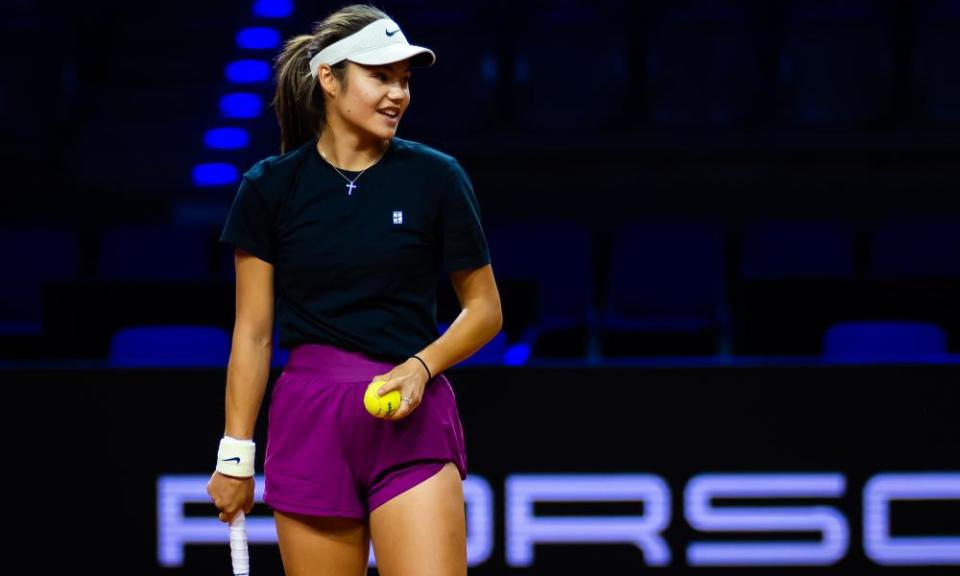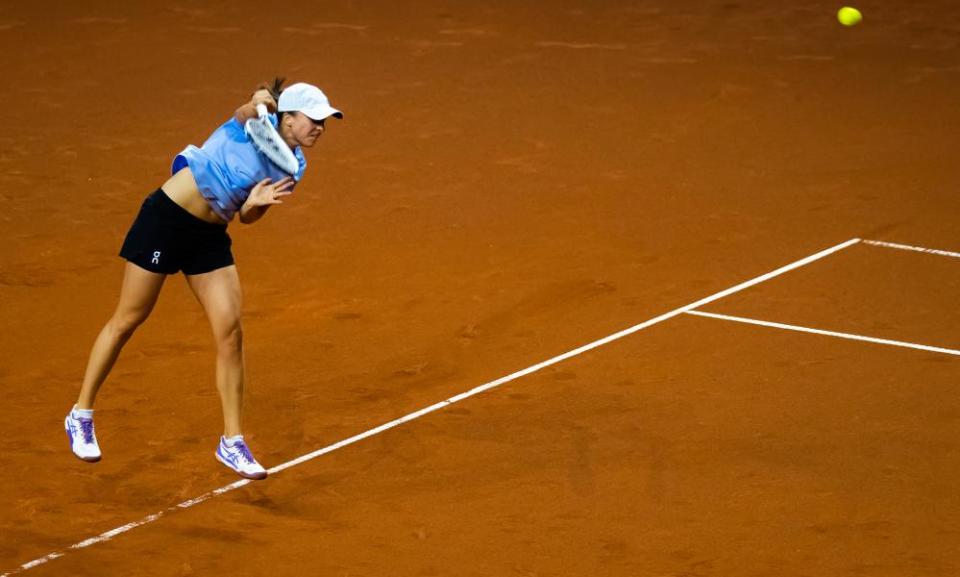Emma Raducanu one of the chosen few as WTA tournament places dry up

Few events signify the refreshing early days of a new clay season in tennis quite like the Porsche Grand Prix in Stuttgart. Over the years this has become one of the most beloved tournaments on the Tour among players and spectators, its popularity reflected in an entry list tightly packed with quality every year.
This year, it is practically the Tour’s own battle royal. Nine of the top 10 players have descended upon the WTA 500 event this week (Tour events are divided into 1000, 500 and 250 categories in order of prestige and prize money) and the lowest-ranked player able to gain direct entry into the small 28-player main draw is ranked 24th. No match is easy. The wildcard Emma Raducanu, for example, will start on Tuesday against fellow grand‑slam champion Jelena Ostapenko, who at No 22 is actually one of the more favourable draws. The No 3 seed Ons Jabeur awaits the winner.
Related: LTA fine from WTA for barring Russian and Belarusian tennis players is halved
The best players in the world grouped so tightly together is the ideal spectacle, but underneath the surface it also quietly demonstrates one of the most significant issues in tennis.
One of the basic functions of the Women’s Tennis Association as a governing body is to ensure that professional players have sufficient playing opportunities each week in order to earn money and attempt to progress in their careers.
Multiple tournaments should be held on weeks without a grand slam or 1000 tournament, yet Stuttgart is the only WTA event on the calendar this week. By comparison, men’s ATP events are currently being held in Barcelona, Munich and Banja Luka. There is an alarming dearth of opportunities for female players to compete at the top level each week.
For the rest of the top 100, the only options were to hope that enough players withdrew in order for them to make the 16‑player qualifying draw, to drop down to lower-level ITF events to compete for fewer ranking points and much less money, or to not compete at all. As a result, the vast majority of players ranked outside the top 32 are inactive this week.

Nine top 100 players have decided to compete in the $100,000 ITF event in Oeiras, Portugal. That draw includes the world No 36, Marie Bouzkova, who reached the Wimbledon quarter-finals last year. The 18-year-old Linda Noskova, one of the most promising youngsters on the Tour, perhaps thought she had graduated to the biggest events when she broke into the top 50. Instead, she is back on the ITF grind. Their presence there creates a domino effect – by filling up draws in lower-level events, players ranked below them are relegated to even smaller events, and so on.
There are mitigating reasons for this empty week in the calendar. The Istanbul Cup, due to be held this week, was cancelled with organisers citing the devastating earthquake in Turkey. The WTA had minimal time to adjust. But this is merely part of a clear, unwelcome pattern. There will be just seven WTA tournaments in April and May compared to 12 in 2019. While the ATP offered up 12 tournaments this February, the WTA again had only seven events, including another week with only one event. Last year, the WTA failed to line up a single tournament in the week after the Australian Open.
The economics for the smaller 250 events has always been complicated. Small events are normally run as local businesses and unless they can boast prominent players or build a presence within the community, it is extremely difficult to break even. Since the Covid hiatus and the cancellation of Chinese events, the WTA has suffered significant financial losses which means it is even more limited in its ability to aid lower-level tournaments. The prize money gap between the ATP and WTA also continues to widen.
Related: France beat Great Britain in BJK Cup as Harriet Dart battles in defeat to Garcia
Meanwhile, the governing bodies have focused on enhancing the bigger events, even at the cost of the rest. This year will mark the first time that both the Madrid Open and the Italian Open, historically one-week 1000 events, will be expanded to two-week tournaments like Indian Wells and Miami. The shift is a consequence of the significant calendar changes implemented on the ATP by its chief executive, Andrea Gaudenzi, and other 1000 events will follow in the future.
The expansion of the two events will have clear benefits – a longer tournament means increased gate receipts, exposure and more prize money. Top players, meanwhile, will receive the benefit of more days off between matches. For players ranked outside of the top 50, though, an early loss will mean they will have to wait around another nine days until they can play another top-level event again and earn another cheque.
With only three WTA 250 events scheduled for the entire clay season, compared to the ATP’s seven, the chances for lower-ranked players who favour clay to make a deep run are extremely limited.
On the court, order continues to emerge after a transitional period. As Iga Swiatek looks to maintain her dominance on clay, and her astounding 47-7 (87%) career record on the surface, players such as Elena Rybakina, Barbora Krejcikova and Aryna Sabalenka will try to hunt her down.
The clashes throughout the clay season, starting this week in Stuttgart, will be gripping. Not every player, though, will have the opportunity to make it on to court.

 Yahoo Sport
Yahoo Sport 






































